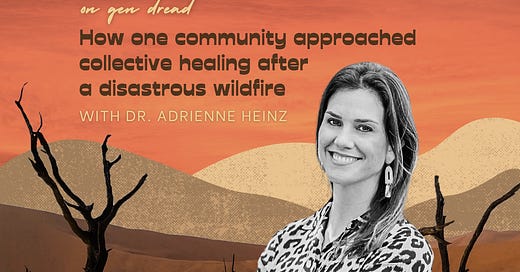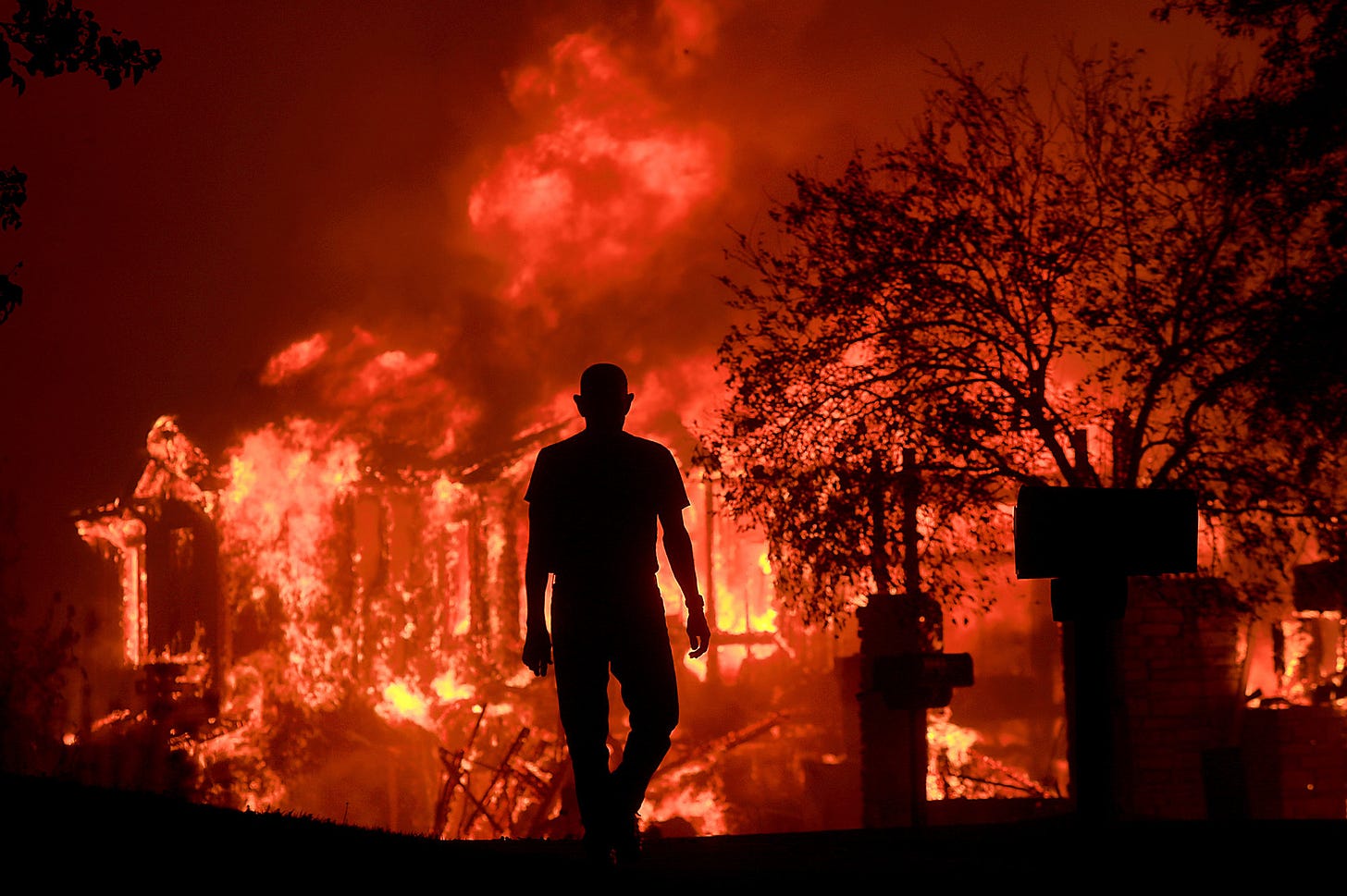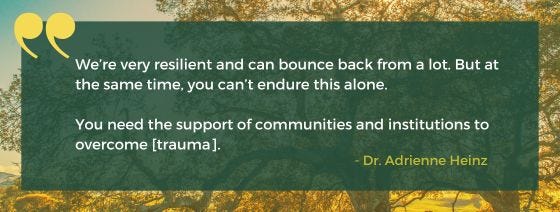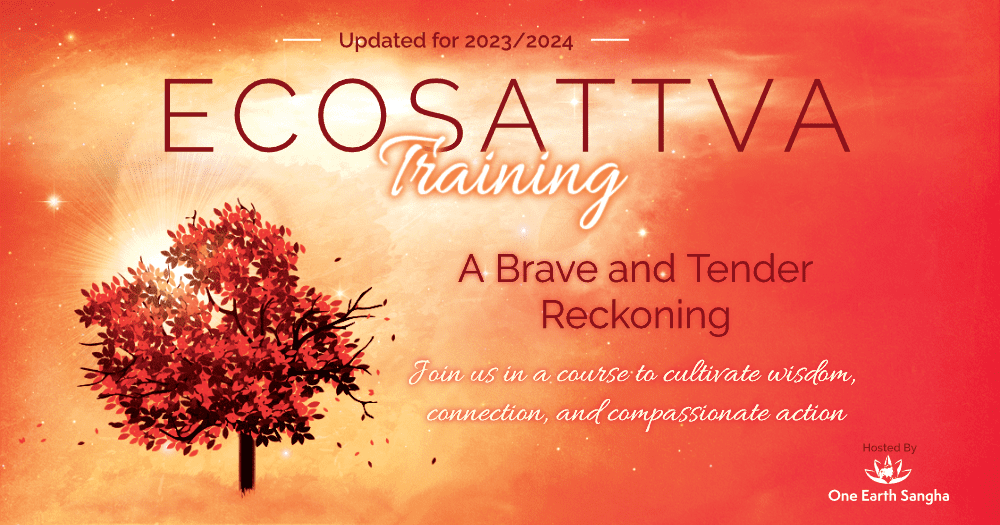How one community approached collective healing after a disastrous wildfire
Dr. Adrienne Heinz explains why disaster recovery is about playing the really, really long game
Dr. Adrienne Heinz never thought of herself as a disaster specialist.
She was working as a clinical research psychologist in Healdsburg, California. But when the 2017 Tubbs fire erupted, she was suddenly awake to new possibilities in her work – specifically, how to create community-based programs for long-term healing after a disaster. Relying on extensive community input, Dr. Heinz and her team created the Sonoma Wildfire Mental Health Collaborative. The healing initiatives they successfully put in place in Sonoma County offer a powerful example of how mental health support can be tailored and accessible to residents in the wake of a climate catastrophe. We sat down with Dr. Heinz to hear more about her story.
GD: So…you didn’t really intend to get into this work. How did that happen?
AH: In 2017, I relocated from San Francisco up to Sonoma County with my family. We were excited for a lifestyle leap. We just wanted a different pace. We threw my daughter's first birthday party on Sunday, October 9th, I believe, or whatever the Tubbs fire was.
That morning I woke up to texts from friends being like, “Are you okay? Are you alive?” And as I lay sleeping – because there were no systems in place to alert people to what was going on – I later found out that 5,000 structures burned and 24 people perished within a matter of hours. And you couldn't go outside safely for three weeks because the air quality was so poor from the smoke and toxic fumes of homes and structures burning. There was this feeling like you were living in a war zone.
I specialize in PTSD and this is a collective trauma. It's a historical trauma, too. At the time, it was the most deadly wildfire in US history. And it compelled me to stop feeling helpless and take the skill sets that were given to me as a mental health professional and provide some literacy about what people might expect when they're in recovery from a climate disaster. A lot of people don't recognize PTSD. They notice like, oh, I've been drinking a lot more. I'm fighting with my spouse or I'm yelling at my kids, or I'm really struggling to sleep from having nightmares. And so it's about empowering people with that knowledge.
Most people will bounce back from this and come back potentially stronger, better versions of themselves and have stronger communities as a result. But we also need support, systemically, to recover from the emotional scars of evacuating with your children in the middle of the night in your pajamas, whatever the clothes are on your back – that's not gonna just magically dissipate. So how do you absorb those narratives into your life in a way where you don't feel fearful of your safety and of the impending climate doom, or that feeling that this will keep happening no matter what you do?
So how did the Sonoma Wildfire Mental Health Collaborative differ from the therapy that had previously been available?
It was born out of this recognition of how collective community trauma actually works. Right after a disaster, there's the whole “let's stand as a community” and “I didn't have it as bad as this person did, so what do I have to complain about?” That’s called comparative suffering. And “the love in the air is thicker than the smoke” and all that. And yes, we had that initial unity.
But then six months later, people are still dealing with insurance claims. They’re displaced, they're living with relatives, they're couch-surfing. They've lost their sense of home and place and belonging. Kids have lost their schools, their homes were burned. So this is not just FEMA coming in for six months and handing out water bottles and diapers. This is going to be a long-term recovery response. And so a lot of concerned mental health professionals came together, recognizing that we need a plan, because otherwise we're going to start seeing the consequences: domestic violence, substance abuse, and suicidality. All the research now shows the impact of disasters in the years later. And so we created programs to help meet people where they are and determine how they wanted to heal.
We had listening sessions from community stakeholders and from there, we developed an app called Sonoma Rises that involves education around disaster. We also had a web-based program called My Sonoma Rises. We had trauma-informed yoga, where we trained 60 yoga instructors to deliver sessions throughout the county for free. We trained over 400 therapists and paraprofessionals, like clergy for example, in skills for psychological recovery – not just in the days and weeks after a disaster, but in the months and years to come. We got disaster-trained therapists into the field, working with people wherever they are. We trained them in different modules: things like problem-solving, building social support – which is the best predictor of recovery after disasters – and then some self-care modules and relaxation. We don't have enough mental health professionals to meet the need. So the future is in paraprofessionals – people who care and have some basic clinical skills to deliver these soft-touch interventions.
It’s maybe similar to experiencing a death – right when the initial shock wears off and you're suddenly feeling all the feelings, everyone who swooped in to help has gone back to their lives.
Exactly. At first, there's all this adrenaline. There's a checklist of things you have to do to get back on your feet. But six to nine months after the fires people need education about what to expect when you've lived through a disaster.What’s the human reaction to this? And what are some red flags that suggest you might need a higher level of care to get back to living the life you want to be living? Some people sought some trauma processing through cognitive processing therapy or prolonged exposure or EMDR, but the majority of folks didn't need that level of specialty care. They just needed connection, shared understanding, and guardrails for what to expect and some tips on how you prioritize your mental wellbeing.
A survivor who's lost everything is thinking about “how am I going to find housing? How am I going to battle insurance? I’ve got to get a new car. I've got to get my kid enrolled in this new school, because their school's been damaged.” There are a million things to prioritize, but we want to help people prioritize their mental health while they're dealing with all those other logistical hurdles that are seemingly more urgent or more pressing – not after.
It's really frustrating because where I come in is usually when people have hit a breaking point where they're having struggles in their relationships, or they have legal consequences from decisions that have been influenced by poor mental health. Or they might be having a health event related to not taking care of themselves – debilitating migraines or other chronic health conditions that are exacerbated by chronic stress. I hate getting people at that end of the spectrum, because this is why we need mental health literacy: to teach people, okay, here's the impact, and how you heal is taking care of yourself. You yourself can heal, you can take care of your family, and then you can tackle this enormous to-do list that will go on for years to come.
The pandemic really put a spotlight on mental health and I think people are kind of getting it. But I think prior to that, it just wasn’t a priority. Mental health was an afterthought or something that you take care of once it's gotten really bad. It's not something you do preventatively. So I think people really appreciated having it normalized and humanized. They appreciated having actual resources out there to catch them if they’re really struggling.
What exactly is trauma-informed care? How does it work in practice?
I'll boil it down to a frame through which you approach the work: it starts with not “what's wrong with you”, but “what happened to you”. It’s about contextualizing and humanizing the consequences of what happened to you, not placing shame or judgment on an individual for what has occurred or that they haven't recovered. It's saying, hey, there are things that happened to you that are going to change how you understand yourself, and how you understand other people in the world. And when those things happen, it's going to shatter your core beliefs about what you hold to be true. And so if we can work with understanding that that shift has occurred, we can also help promote healing by understanding: where have your feelings of safety and trust and empowerment been ruptured, and how can we repair this?
Then there’s also a somatic component. When we have trauma, we store it in our bodies. Evolutionarily, we're programmed to do that. And so recognizing that people have different responses – like hot, warm, windy nights here cause a somatic reaction. And normalizing that. It’s about working with people where they are and not viewing them as a pathology or disease. It's about seeing them as humans who are trying to get back on their feet after a terrible thing has happened. A lot of trauma responses are very utilitarian: like, think about how effective it is to smoke weed, or drink a lot, or disassociate and be conflict avoidant. If you can do those things, you don't have to re-experience those terrible feelings.
How does self-care work within a society that doesn't make a lot of space for mental health? How do we reconcile what we want individual people to do with a wider society that doesn't really allow for it?
I think the messaging is starting to evolve. And I'm glad it's part of the conversation, because it used to not be. But I think where it has bummed people out or it doesn't quite resonate is this idea of, “I need to rest and do self care…in service of being more productive at work, more engaged as a parent, or getting more done at home”... versus resting to just, like, restore your soul. There’s emotional rest, cognitive and mental rest, creative rest, there’s spiritual rest. And I think when we recognize there's these different facets of rest and that we need them in order to get back in tune with our own intuition, that I personally find that more encouraging. “Why don't you go do yoga so you can get your TPS report done faster”, yeah, no. You have the right to rest because you're a human being. The end.
If you liked reading this, feel free to click the ❤️ button on this post so more people can discover it on Substack 🙏🏼
Making Waves
One Earth Sangha’s newest EcoSattva Training is open now, this course is a journey of brave and tender reckoning with a dramatically changing world. As the participants cultivate clear seeing, supported by radical Dharma wisdom, justice-informed analysis, and a growing community of engaged practitioners, the participants may discover new pathways opening to them. Registration for this self-paced training is open now, and you can start whenever you wish. Gen Dread’s Britt Wray is a featured interlocutor in this year’s program.
As always, you can share your thoughts and reach the Gen Dread community by commenting on this article or replying to this email. You can also follow along on Twitter and Instagram.
‘Till next time!










Thank you! So helpful. Normalizing our human reactions and encouraging room for healing is so useful.
This was so inspiring to read! What an amazing example of community healing. Thanks team Gen Dread 💜